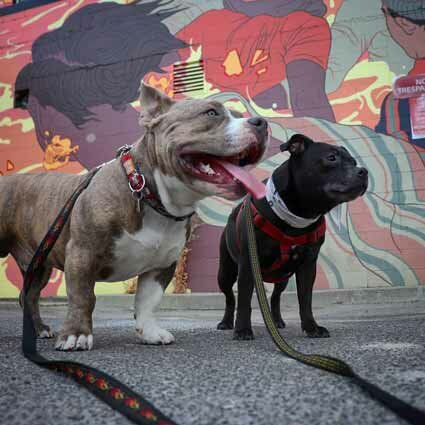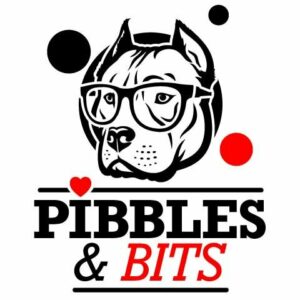The English Bull Terrier is known for its larger than life personality. Often referred to as a clown dog, or “the kid in a dog suit”. Their fun loving nature, and affection towards their human owners makes the Bull Terrier a truly unique dog. They are also known for being one of the weirdest looking dogs out there. With their unmistakable unique egg-shaped heads, and distinct triangular eyes.
So why do Bull Terriers look so weird? The Bull Terrier’s uniquely egg shaped head is a result of 100 years of selective breeding practices. Many refer to the Bull Terrier’s appearance as strange, weird, or even deformed. They are however the result of intention breeding to remove the Bull Terrier’s nose stop to form the unusual look we know today.
The unique history of the Bull Terrier is as interesting as their weird and unique appearance. From the early days of vermin hunting and bull baiting, this weird looking dog has seen a variety of changes throughout the years. Resulting in giving them not only their distinct features, but personalities too.
Why do Bull Terriers Look Weird?
Many people wonder, why do bull terriers look weird. The answer is – bull terrier is the mix of two breeds – terriers and bulldogs. Bull terriers have a distinctive appearance, like egg-shaped heads. The origin of these dogs came by combining two different breeds, creating the bulldog’s strong jaws and the terrier’s longer snout.
Why do bull terriers look so weird? Over time, this hybrid breed further changed, giving bull terriers their unique and weird appearance. These dogs were bred as pets, leading to breeding practices focused on aesthetics rather than functional traits.
Bull Terriers Haven’t Always Looked So Weird.
So in general you know why do bull terriers look like that, but let’s dive deeper into origins. When you think of the English Bull Terrier you immediately begin to imagine the oval shaped head surface. Devoid of hollows or indentations, much like an egg shape.
A curve from the top of the skull to the tip of the nose and a flat forehead from ear to ear. This odd looking version of the Bull Terrier has only really been around since the 1950’s even though the breed has been recognized by the AKC since the 1860’s.
Taking a trip into the way back machine we know that like many of the other bully breeds in existence today, the English Bull Terrier originated from the early 1800’s “bull and terrier” dog. These dog were a cross between an Old English Bulldog and various terrier type dogs.
The main purpose of this was to create a tenacious vermin hunter and a blood-sport competitor. By combining the speed and agility of the terrier with the tenacity and pain tolerance of a bulldog we produce a “bull and terrier”.
The appearance of these early “bull and terrier” breeds were not as important as the performance was in the various blood sports. Therefore any sort of breed standards at the time were loose at best.
This eventually led to a divergence in the breed to what we now know as the Bull Terrier and Staffordshire Bull Terrier.
What did Bull Terriers Used to Look Like?
Wondering, what did bull terriers used to look like? In 1915, bull terriers had a fairly attractive appearance with well-proportioned heads. They had agility, grace, elegance, and determination.
To answer, why do bull terriers look different? It’s because bull terriers went through crucial physical changes. They were bred to have a football-shaped head and a compact, stocky body, quite different from before. They now look like the shape of an oval.
Refining The Weird Look Of The Bull Terrier
It wasn’t until the mid 1800’s that a particular gentleman by the name of James Hinks took a particular interest in the bull and terrier breeds and began to breed the now extinct English White Terriers with his Bulldog “Madman”.
Hink was looking for a more gentlemanly, and cleaner appearance in the breed. The Bull Terrier James Hinks began breeding did not yet have the egg shaped head we now know but kept the stop in the dog’s nose.
These dogs were called the “Hinks breed” and the “White Cavalier”. James Hinks pursued a breed that was for a gentleman’s companionship rather than a blood sport champion.
This breed of dog was instantly popular and breeding continued, using Dalmatian, Spanish Pointer, and Whippet to increase elegance and agility; and Borzoi and Rough Collie to reduce the stop.
It wasn’t until 1917 when “Lord Gladiator” came onto the scene that the breed was officially recognized by the AKC. Lord Gladiator was the first Bull Terrier dog with no stop at all.
James Hinks initially bred the Bull Terriers to be completely white, adding to their gentleman’s companion persona. Sadly as with many pure white breed dogs, many health problems, including predispositions to deafness, ensued.
The introduction of breeding Staffordshire Bull Terriers into the line began in the early 20th century creating the now separate colour varieties of Bull Terriers such as red and brindle Bull Terriers.
Though Lord Gladiator was recognized as the first modern Bull Terrier, even his appearance from today’s Bull Terriers are noticeable. It took many more decades of selective breeding for the more downward curved appearance to reach the Bull Terrier we know today.
What Are Some Of The Health Issues For Bull Terriers?
Like all dogs Bull Terriers are prone to health issues, but some are more common in Bull Terriers. If you are getting a new puppy be sure to thoroughly vet your breeder and ensure they give you a health guarantee.
Discuss the health problems that are common in the breed, and any predisposition in the breeders line of dogs. Some of genetic health problems that have been seen in the breed include:
- Heart disease – Heart murmurs can be present in puppies, but they often outgrow them. If this murmur has not disappeared by 12-15 months old it’s a good idea to have an examination to determine if heart disease is an issue.
- Deafness – Around 20% of pure white Bull Terriers and just over 1% of the color variations experience deafness. Have your breeder and vet check at any early age for any signs of hearing loss or deafness.
- Polycystic kidney disease – is a progressive and irreversible kidney disease that often results in renal failure. It is a breed-specific syndrome in Bull Terriers.
- Skin Problems – Like many bully breeds Bull Terriers are prone to skin issues that may cause excessive itching, hair loss, and discomfort for the dog
- Luxating patellas – is a knee cap that moves out of its normal location and can make walking and weight bearing difficult for the dog.
- Spinning – THIS behavior can become very problematic, many Bull Terrier’s will get into the habit of obsessively in an OCD manner of spinning and will spin for hours at a time. Spinning may be a type of seizure and is sometimes successfully treated with medications. Contact your vet for more information.
- Eye disorders, such as ectropion and keratoconjunctivitis sicca, or dry eye.

Join the adventures of Ruby The Staffy & Chester The Pocket American Bully!
Subscribe to our YouTube Channel!
Are Bull Terriers Aggressive?
Bull Terriers are full of fun loving energy, spunk and personality, far removed from their roots in the dog fighting sports of the early 1800’s. The Bull Terrier is however a strong and at times stubborn dog that may not take well to other unfamiliar dogs especially males meeting other male dogs.
It is always best to exercise caution when introducing your Bull Terrier to another unfamiliar dog and monitor playful activities so they do not escalate to a fight.
Obedience training is a must for the Bull Terrier. Early socialization with other dogs, people, and environments, along with the strong guidance of the owner can pay great dividends in having a well balanced happy, healthy dog in your life.
Daily exercise is also a crucial component to ensure you are directing the high energy dogs activities to a happy and healthy activity.
Do Bull Terriers Make Good Family Pets?
Bull Terriers can be a great addition to a family dedicated to the training and care of this fun-loving goofball of a breed. They are very high energy dogs, with a love of games, and interacting with their family members.
Bull Terriers are highly loyal and oftentimes protective of their human friends. They are great with children but are not big fans of being teased or generally messed with. It is important to monitor play activities with children and teach them how to properly interact with your Bull Terrier.
Bull Terriers are highly independent free thinkers with a commitment to FUN! If left to their own devices and bored they can become destructive and tear up your favorite pair of shoes.
Be sure you are ready to match the energy level of the Bull Terrier and give them plenty of opportunities to exercise and play.
The Bull in the Bull Terrier can make them a fairly stubborn breed. If they don’t see the fun in a certain activity, they might simply not want to do that activity.
They may not be the best first time dog for a family due to their stubborn and tenacious nature. Obedience training from an early age will be an important part of bringing your new family member into the fold and maintaining a happy relationship.
PIBBLES & BITS TOP PICKS
King Komb DeShedding Tool – One of the best dog brushes on the market. I use the King Komb each and every week with my Pibbles. Easy to use and even easier to clean.
Wahl Dry Skin Oatmeal Shampoo – Smells great, cleans great, and best of all keeps my dog’s skin and coat looking and feeling amazing. Wahl Dry Skin Oatmeal Shampoo keeps my Pibbles skin moisturized like no other.
Earth Rated Dog Wipes – Dog wipes are an essential to keep on hand, and nothing beats Earth Rated. Hypoallergenic, biodegradable, and durable. I keep these dog wipes in the house and the car for everyday use.
Kong Extreme – Kongs are one of my most used tools to give my dogs some mental stimulation and something tough to chew. Kong Extremes are as tough as they come and will give your Pibble the entertainment they crave.
Outward Hound Food Puzzle – Outward Hound food puzzles are the best in the industry. Available from beginner to advanced. These are an excellent way to challenge and mentally stimulate your dog.
BeneBone Dog Chew – The toughest dog chew around. My dogs absolutely love the bacon flavor and peanut butter flavor BeneBone. These will keep your toughest chewers busy for weeks, if not months and years.
BarkBox Super Chewer – Variety is the spice of life, and BarkBox Super Chewer is the perfect way to keep your dog engaged. New treats, toys, and chews each and every month that your super chewer will love.
iCrate Dog Crate – The iCrate is my absolute top recommendation for dog crates. I use this for both my dogs and love the sturdy, easy to store, and versatile adjustable panel. You need the iCrate in your life.
HiKiss Long Training Lead – Recall training and puppy training outdoors requires a long training lead. My favorite to use is the HiKiss long training lead. Available in a range of lengths to suit your long lead training needs.
